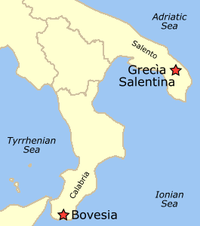
Back İtaliyada yunanlar Azerbaijani Италияла гректар Bashkir Έλληνες στην Ιταλία Greek Italian kreikkalaiset Finnish Greci in Italia Italian ბერძნები იტალიაში Georgian Грци во Италија Macedonian Италиянь грекень ломанть MYV Italogrecy Polish Греки в Италии Russian


 Cemetery behind San Giorgio dei Greci, Venice | |
| Total population | |
|---|---|
| 90.000 - 110.000d [1][2][3] | |
| Languages | |
| Italian, Greek, Griko | |
| Religion | |
| Catholic, Greek Orthodox |
Greeks in Italy have been present since the migrations of traders and colonial foundations in the 8th century BC, continuing down to the present time. Nowadays, there is an ethnic minority known as the Griko people,[4] who live in the Southern Italian regions of Calabria (Province of Reggio Calabria) and Apulia, especially the peninsula of Salento, within the ancient Magna Graecia region, who speak a distinctive dialect of Greek called Griko.[5] They are believed to be remnants of the ancient[6] and medieval Greek communities, who have lived in the south of Italy for centuries. A Greek community has long existed in Venice as well, the current centre of the Greek Orthodox Archdiocese of Italy and Malta, which in addition was a Byzantine province until the 10th century and held territory in Morea and Crete until the 17th century. Alongside this group, a smaller number of more recent migrants from Greece lives in Italy, forming an expatriate community in the country. Today many Greeks in Southern Italy follow Italian customs and culture, experiencing assimilation.
- ^ "Grecia Salentina official site (in Italian)". www.greciasalentina.org.org. Archived from the original on December 31, 2010. Retrieved February 1, 2011.
La popolazione complessiva dell'Unione è di 54278 residenti così distribuiti (Dati Istat al 31° dicembre 2005. Comune Popolazione Calimera 7351 Carpignano Salentino 3868 Castrignano dei Greci 4164 Corigliano d'Otranto 5762 Cutrofiano 9250 Martano 9588 Martignano 1784 Melpignano 2234 Soleto 5551 Sternatia 2583 Zollino 2143 Totale 54278
- ^ Bellinello, Pier Francesco (1998). Minoranze etniche e linguistiche. Bios. p. 53. ISBN 9788877401212.
Le attuali colonie Greche calabresi; La Grecìa calabrese si inscrive nel massiccio aspromontano e si concentra nell'ampia e frastagliata valle dell'Amendolea e nelle balze più a oriente, dove sorgono le fiumare dette di S. Pasquale, di Palizzi e Sidèroni e che costituiscono la Bovesia vera e propria. Compresa nei territori di cinque comuni (Bova Superiore, Bova Marina, Roccaforte del Greco, Roghudi, Condofuri), la Grecia si estende per circa 233 kmq. La popolazione anagrafica complessiva è di circa 14.000 unità.
- ^ "Hellenic Republic Ministry of Foreign Affairs, Italy, The Greek Community". Archived from the original on July 17, 2006. Retrieved October 12, 2015.
Greek community. The Greek diaspora consists of some 30,000 people, most of whom are to be found in Central Italy. There has also been an age-old presence of Italian nationals of Greek descent, who speak the Greco dialect peculiar to the Magna Graecia region. This dialect can be traced historically back to the era of Byzantine rule, but even as far back as classical antiquity.
- ^ PARDO-DE-SANTAYANA, MANUEL; Pieroni, Andrea; Puri, Rajindra K. (2010). Ethnobotany in the new Europe: people, health and wild plant resources. Berghahn Books. pp. 173–174. ISBN 978-1-84545-456-2.
ISBN 1-84545-456-1" "The ethnic Greek minorities living in southern Italy today exemplify the establishment of independent and permanent colonial settlements of Greeks in history.
- ^ "Greek MFA: Greek community in Italy". Archived from the original on July 17, 2006. Retrieved April 4, 2008.
- ^ G. Rohlfs, Griechen und Romanen in Unteritalien, 1924.